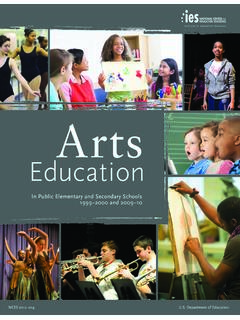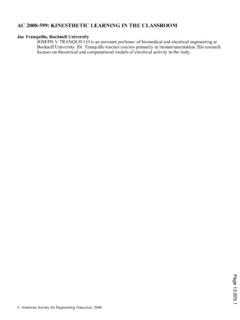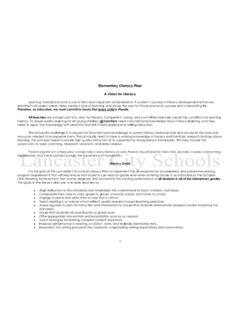Transcription of Effective Integration of Music in the Elementary School ...
1 : inquiry in educationVolume 9|Issue 2 Article 42017 Effective Integration of Music in the ElementarySchool ClassroomJames DiDomenicoNational Louis University, this and additional works at: 2017 by the author(s) : inquiry in education is published by the Center for Practitioner Research at the National College of Education, National-Louis University, Chicago, CitationDiDomenico, James. (2017). Effective Integration of Music in the Elementary School : inquiry in education: Vol. 9: Iss. 2, Article from: Effective Integration of Music in the Elementary School classroom James DiDomenico National Louis University, Chicago, USA Introduction For the past 25 years, I have been fortunate enough to call my gig as a performing musician my day job.
2 I have also always loved working with children, and they, for reasons I do not always understand, seem to love working with me. I have often believed that teacher was what I was intended to be, and a blessed 25-year career as a musician just got in the way of that. My musical background and my desire to be the best teacher I can be are what have now led me to wonder about Effective Music Integration in the classroom and throughout the curriculum. This project was conducted as part of the requirement for a practitioner-oriented research course within my teacher education degree program at a private nondenominational Midwestern university. The purpose of the project was twofold: (a) to investigate ways in which Music can be integrated into the Elementary School curriculum; and (b) to examine how Music can serve as a medium of both improving the overall class environment and promoting a better understanding of the curricular material.
3 Literature Review After spending quite a bit of time searching for and reviewing various academic sources on this topic, it became clear to me that there is quite a variety of ways that Music is being used effectively in the classroom . I have consolidated these musical Integration concepts into four themes which appeared to be most pronounced. The first theme addresses the use of Music for curricular learning of traditional subjects such as math and language arts. The second theme, while related to the first one, focuses on how Music is used as a means of personal expression and creativity. The third theme deals with how Music is used to alter mood in classrooms.
4 Finally, the fourth theme centers on how classroom cohesiveness and classroom management can be enhanced with the use of Music -related activities. However, I would be remiss if I did not begin the Literature Review section with a discussion on a concept that provided the foundation of all four themes and was evident in several of the different articles I read, that of Howard Gardner s theory of multiple intelligences (Gardner, 1983). Multiple Intelligences Theory In 1983, Howard Gardner published his widely acclaimed book, Frames of Mind: The Theory of Multiple Intelligences, in which he proposed that intelligence is not simply one entity but rather many different forms of intelligence.
5 He distinguished between eight different intelligences: 1 DiDomenico: Effective Music IntegrationPublished by Digital Commons@NLU, 2017 linguistic, logical-mathematical, visual-spatial, bodily-kinesthetic, interpersonal, intrapersonal, naturalist, and musical. Of particular interest for this project is Gardner s notion of musical intelligence. Gardner affirmed what some teachers had always believed, that is, that traditional paper-and-pencil language arts tests and logical mathematical tests were not enough to measure a student s intelligence. Gardner s findings were the catalyst to new ways to learn and assess learning. Kassell (1998) wrote that the multiple intelligence teaching model emphasizes education for understanding and application not just the memorization of rote facts.
6 Gardner thought, for example, that if a student was having difficulties understanding a principle in mathematics (the content), then the teacher could provide an alternative route (pathway) to understanding the concept using one of the other intelligences as a medium for comprehension. Kinney (2012) gives us a straightforward example of a student who does not enjoy expressing himself through traditional language arts mediums. Kinney describes how a student named Christopher performs very poorly in School ; however, he loves writing lyrics and creating rap Music . Christopher s songwriting motivates him to spend several hours a day after School working on writing expressive lyrics for his recording projects, thereby confirming Gardner s ideas.
7 Gardner s multiple intelligence theory has a particular relevance to Effective Music -based teaching strategies and activities. Music for Curricular Learning There is a plethora of studies focusing on various Music -centered strategies to aid in the comprehension of subject matter in the curricular areas of language arts, mathematics, social studies, and science. For example, Smith (2002) points out the most unequivocal example of Music use in the classroom : Millions of English-speaking children have learned the names of the alphabet letters more easily because someone set them to the tune of Twinkle Twinkle Little Star (p. 646). This concept is the simplest, yet best example of the use of a Music activity to learn curricular material.
8 Smith goes on to suggest that adapting other popular children s songs to teach different literacy or mathematics concepts is very Effective for comprehension. Dyer (2011) is also a major proponent of using Music -based activities to further literacy skills. Dyer suggests that Music increases Elementary students engagement, helps with memory and recall, and enhances phonemic awareness during literacy instruction. Feinstein (2006) states that the human brain is built for sound: Hearing is the first sense to develop in the womb, establishing brain structures for processing sound (cited in Dyer, 2011, p. 238). Oral language and Music are intimately connected, and the brain processes Music and language using the same structures.
9 Feinstein goes on to say that neuroscience shows that the same left brain region designated for split second discrimination between sounds like pa, ba or da is activated during Music listening (cited in Dyer, 2011, p. 6). Zull (2002) discusses the concept of using Music activities as a great way to reduce habituation in the classroom . Habituation is the process of gradually tuning out a repeated sound (like a teacher s lecturing voice), and using Music to vary sounds in the classroom can reduce this effect, increase brain activity, and ensure that what the teacher is teaching actually gets heard (as cited in Dyer, 2011). Dyer (2011) quotes Jensen (2000) who says that Music carries with it more than just feelings: The melody can act as a vehicle for words, as well (p.)
10 5). : inquiry in education, Vol. 9 [2017], Iss. 2, Art. 4 Dyer (2011) suggests that learning happens most effectively when students have high interest levels and strong emotional connections to the material. Dyer (2011) quotes Jensen (2000) who says that Music carries with it more than just feelings: The melody can act as a vehicle for words, as well. Students remember and retrieve information more effectively when they can link that information to Music (p. 5). Music has one other benefit, she adds; it increases phonemic awareness through pitch discrimination and the differentiation of sounds in speech. Kinney (2012) adds, Lyric writing can be linked to instruction on prosody, intonation and phrasing (p.















